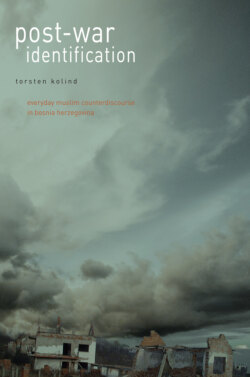Читать книгу Post-War Identification - Torsten Kolind - Страница 23
Chapter 2
The unmaking of the world
ОглавлениеIn order to fully understand the remaking of the world that my informants engage in – and especially the elements of resistance and counterdiscourse involved in this remaking – it is important to realise how profound and severe the unmaking of their world has been. As I will argue, the unmaking of my informants’ world has forced them to re-question previously taken-for-granted social relations, values and moral categories: in other words, to re-identify themselves and the ethnic other. Both during and after the war, an ethnonationalist paradigm was the dominant explanatory device available for explaining people’s misfortunes, as well as a central element in the remaking of people’s shattered lives. An element of counterdiscursive resistance is therefore legible when people refuse to give ethnonationalist discourse the upper hand in the remaking of the unmade world.
In this chapter, I outline some of the central events and experiences in the unmaking of my informants’ lives. First, however, some terminological clarification is necessary, for, as touched upon in the previous chapter, the distinction between the world’s unmaking and its remaking is a necessary theoretical fiction. In the first place, attempts at holding on to mundane everyday practices – however much of a caricature this may seem – are characteristic of wartime life. Povrzanović tellingly calls this practice/strategy of attempting to stick to ‘minimal normality’ (Maček 2000a) ‘imitations of life’ (Povrzanović 1997: 157). The unmaking of the world and the remaking therefore take place simultaneously. However, the object of my study is a post-war society, not a war-time society. Though my informants’ lives were still darkened by the shadow of the war, they no longer feared for their own lives. And despite their difficult social situation my informants still felt that in general things had improved since the end of the war. So, whereas in a situation of war it would be accurate to describe unmaking and remaking as simultaneous, in Stolac today people are more occupied with attempts at understanding, forgetting and forgiving. These forms of remaking are qualitatively different from the wartime ‘imitation of life’ which they superficially resemble. On the other hand, it is still important to acknowledge how destructive the tough post-war situation has been to people’s hopes and dreams, as well as their meaning-creating narratives, which are still severely damaged. In one sense, then, a process of unmaking is still going on.
Analysing the unmaking of my informants’ lives centres on two core aspects: the everyday world and epistemology. Firstly, by ‘everyday world’ I mean the non-conscious routine practices and categories one employs to make sense of events, including other people’s actions. Moreover, such non-conscious acts and categories can often easily become the object of conscious reflection. It is this domain that much phenomenologically inspired anthropology has tried to analyse and conceptualise. For instance, the non-conscious constitutes a central component in Bourdieu’s concept of habitus (1995) as well as Arthur Kleinman’s ‘local moral worlds’ (1992). For an overview see Jackson (1996). The everyday routine world has also been a focus of ethnomethodology. For example, Garfinkel’s studies (1963, 1967) have revealed the existence of an implicit everyday morality, a largely hidden taken-for-granted world with unwritten assumptions about the dos and don’ts of social life, which is the basis for people’s situational strategies. But Garfinkel’s work also reveals how seemingly minor and in a way imperceptible changes in people’s behaviour can radically disrupt the neat flow of social interaction, creating feelings of confusion. In a similar way, Goffman’s extensive studies of face-to-face interaction have shown that the individual’s use of social identities as well as the social expectations attached to such use (in sum impression management) is dependent on predictability in social interaction (the interaction order) (1971, 1974, 1983). In sum, the everyday world possesses a taken-for-granted-ness that is fundamental to processes of identification of oneself and the Other, and to avoid feeling bewilderment and confusion. And it is the damage to such everyday worlds with their predictable social routines and identities that constitutes a core element in many people’s war experiences.
The second aspect of the unmaking of the everyday world relates to the loss or failure of epistemological frameworks. As mentioned, Scarry’s work (1985) describes how the experience of torture is often non-communicative, because the categories and concepts its victims would normally use to communicate experience no longer suffice.1 This is why the victims of terror and war-related violence often state that they cannot describe what happened, that they do not have the words, or that strangers will not understand (Maček 2001, Mertus 1997, Povrzanović 1993, Perera 2001). The ability to communicate experiences of violence is restricted because the mental categories normally used for making sense of the world are themselves shattered by the unprecedented events of war and violence (Zur 1998: 159-91; Nordstrom 1997: 153-75). In sum the world’s unmaking forces its victims to redefine their social worlds from minor mundane practices to more overall values and ideals.
In the rest of the chapter, I will describe my informants’ experiences during and after the war in terms of four aspects of the unmaking of the world. The destruction of the everyday world, stories and communication, and finally the all-pervasive feeling of loss.
